
| Disable the Flashing Parking Lights When Operating the Remote Door Locks of a 2006 Itasca Navion (or Winnebago View) |
|
by Ellsworth Chou
|
Since acquiring our 2006 Navion 23J this summer, I've progressively changed or improved systems so that the Navion more closely suits our needs. One constant irritation was the original Chrysler/Mercedes Sprinter's routine of flashing the exterior running lights whenever the remote door locking key fob is actuated. Presumably this feature is provided to: 1) indicate whether you've unlocked or locked the doors, depending upon how many times the lights flash, and perhaps 2) to locate your vehicle in a parking lot. As for the former, the only method for determining locking state that matters for a Winnebago View/Itsasca Navion owner is the sound of the "house door" latching or un-latching (if you find the behavior of your remote and the "house" door of your View/Navion puzzling and frustrating, see my modification of the V/N to sense the state of the house door). As for locating the vehicle with the flashing lights, if you can't see a 10 and a half foot tall motorhome within the puny 60-80 foot maximum range of the remote fob, flashing the lights probably won't help.
More to the point, the flashing lights are downright annoying when you're discreetly trying to enter/exit your motorhome. In a sleepy campground at 11pm, the flashing lights are downright blazing - in addition to disturbing your neighbors every time you lock/unlock your doors remotely, destroying any night vision you might have just developed walking through the campground. In our driveway, every time I go into the Navion at night (which always seems to be 2am or so - I'm a night owl) to get something, I light up the fronts of all the houses in our cul-de-sac, as well as announce my presence in the driveway. As I said, irritating.
I was deterimined to disable the flashing lights, and was successful after a bit of exploratory work under the driver's seat of the Navion. If you have moderate mechanical skills, you can make the modification in an hour or so. Here's how:
WARNING: This procedure involves the removal and re-installation of the seat assembly, to which is attached the seat belt system. This is a critical safety component, and bears the very serious load of many dozens of times your body weight in the event of a collision. If you are unfamiliar with the use of mechanical fasteners (six bolts, in this case), consider having this work done by a professional.
No guarantees are made that this procedure is safe, will not cause damage to you or your vehicle, or will work on any other Itasca Navions or Winnebago Views. This is a procedure I performed upon our own personal vehicle, and share here with the world for any other users who are willing to accept the risk of modifying their own vehicle.
TOOLS REQUIRED
Disabling the flashing lights involves un-plugging two relays from beneath the driver's seat of the Navion. Though it might be possible to do this without removing the seat and rails, I think it's much easier to remove it. Under the seat of the Navion, a fiberboard panel must be removed to access the relays below - in our Navion (which we bought used), this panel has been adrift, having never been re-secured with screws during some previous service, so I could actually touch the relays without removing the seat, but it was still too awkward to remove the relays. So remove the seat I did.
First, disconnect the main chassis battery under the hood. Be sure that the "Battery Boost" switch on the dash is NOT turned on (this switch connects your house batteries to the chassis for emergency starting purposes).
(click and hold on any images on this page to enlarge them)
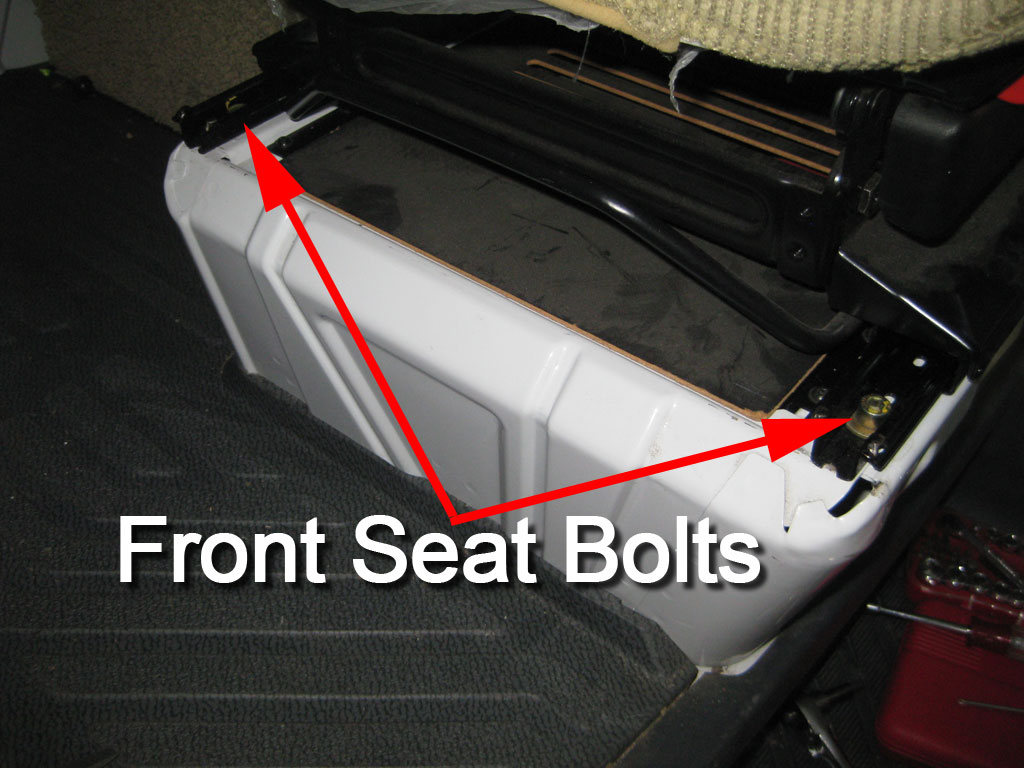 |
| (2) front seat 6mm Allen bolt locations |
Slide the driver's seat fully rearward. Use a 6mm Allen bit in a ratchet to remove one bolt on each side, located inside the seat rails (see "Front Seat Bolts" image above). These will require some force to break loose. Note that a silver oblong washer may be located under each bolt, in the rail channel. Retrieve these washers and keep them with the bolts.
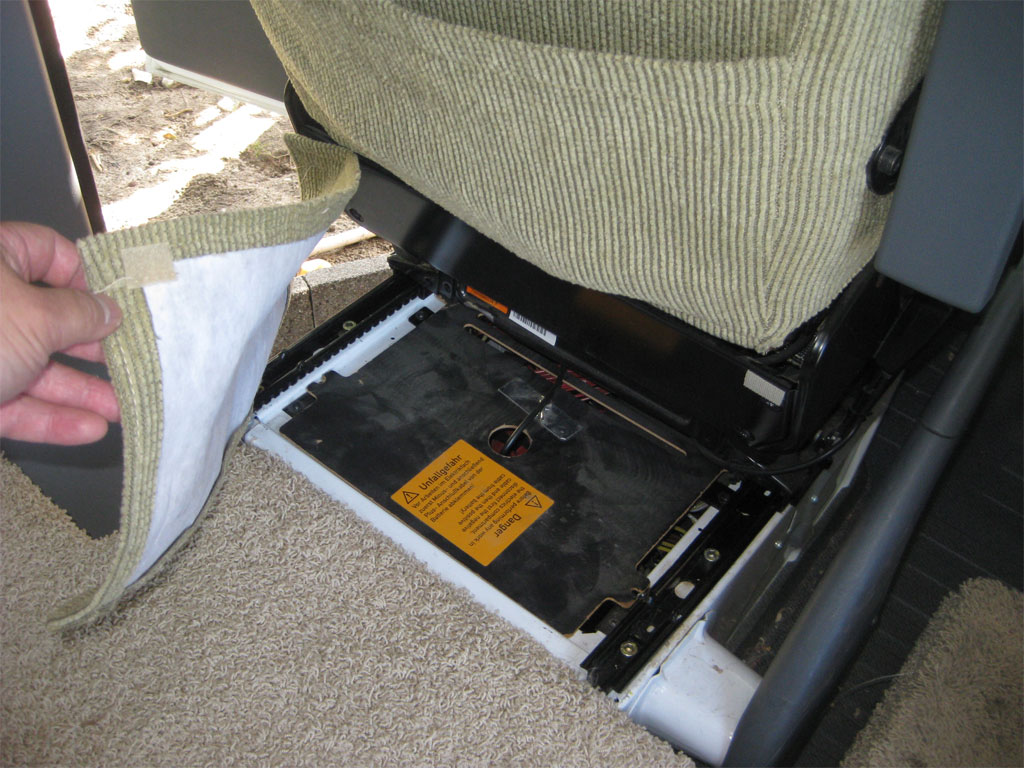 |
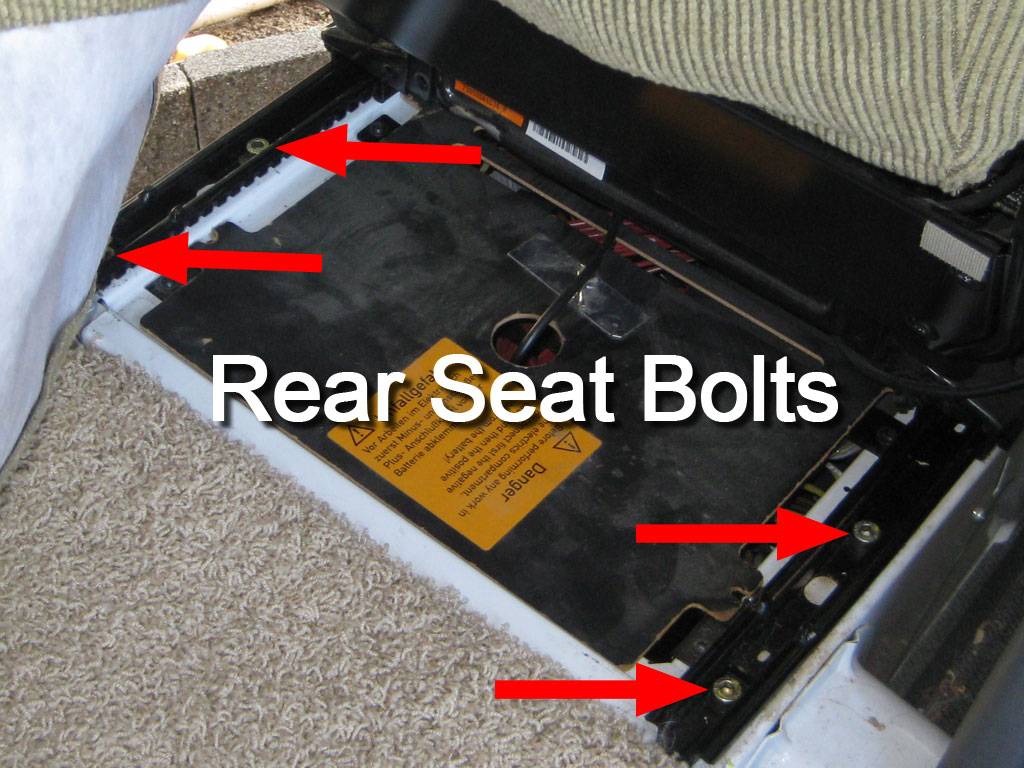 |
| Remove fabric skirt to reveal underseat components | (4) rear seat 6mm Allen bolt locations |
Now slide the seat fully forward. A decorative fabric skirt hangs from Velcro tabs at the bottom of the seat back - removing this eases access to the underseat area. This exposes two bolts in the rear of each of the seat rails (a total of four).
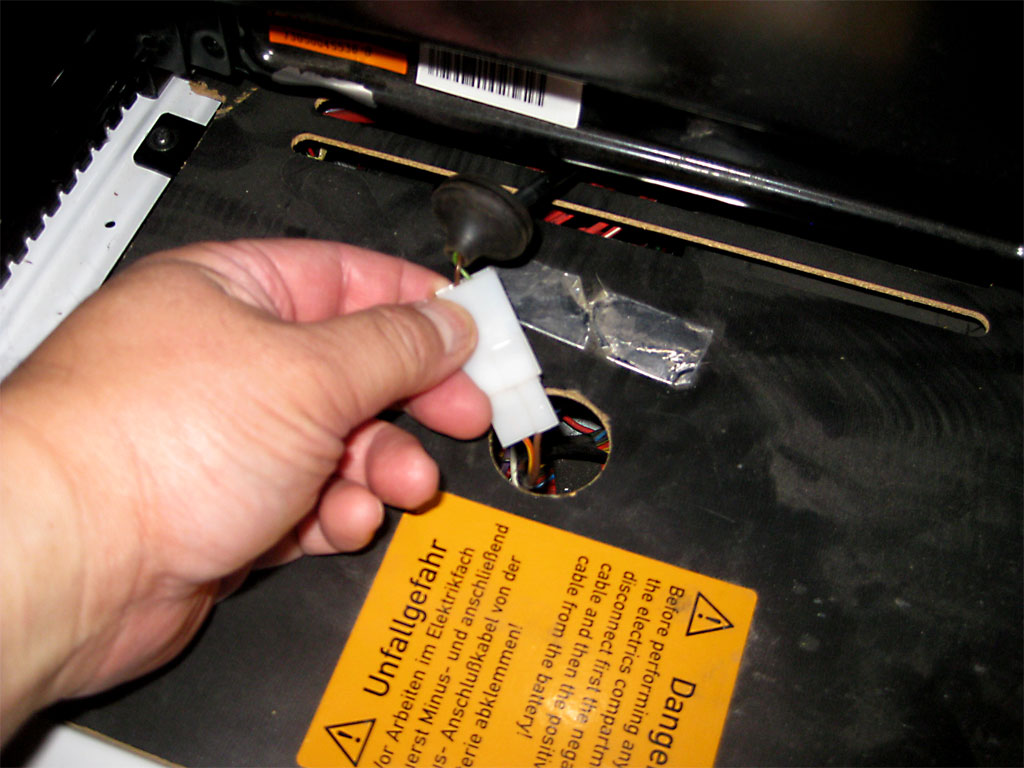 |
| Seat belt sensor connector under driver's seat |
The connector in the photo above connects the seat (probably a seat-belt warning sensor) to the chassis. This may have to be fished from under the fiberboard cover (above seen with the yellow warning sticker). Unplug the two halves of the connector. There is no locking mechanism - it may require a firm pull, being careful not to pull the wires. Secure this wire in a position in which it will not be pinched when moving and re-installing the seat.
Again using the 6mm Allen driver, remove two bolts from each or the rails - four in all.
The seat is now free to move, with the exception of still being connected to the shoulder belt. I chose not to disconnect the seat belt, since the seat can move adequately with the belt still attached. I placed a clean 12" x 24" piece of plywood on the carpeted area just rearward of the seat to protect the floors and carpet from grease and scratching. I could then simply move the seat off the welded steel box to the plywood. The seat is somewhat heavy, so be careful when moving it.
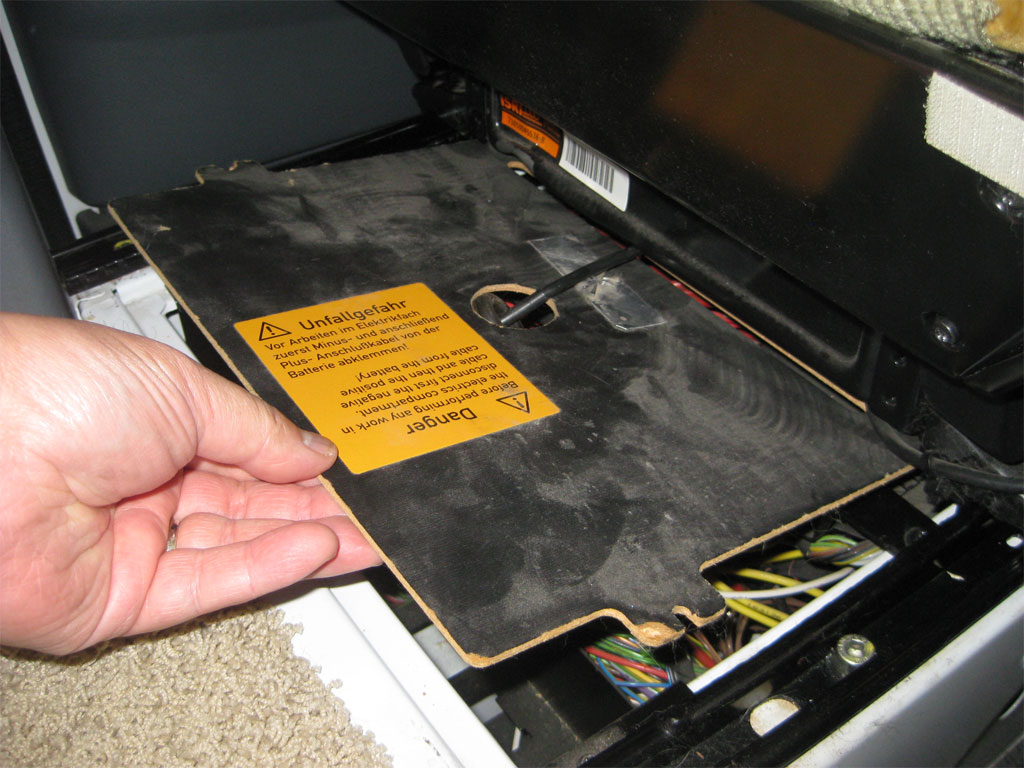 |
| The fiberboard cover for the driver's underseat box |
Once the seat has been removed, you will remove the black fiberboard cover through which the seat belt sensor wire passes. Four T-25 Torx bolts hold down this board. Remove them and the board and set aside.
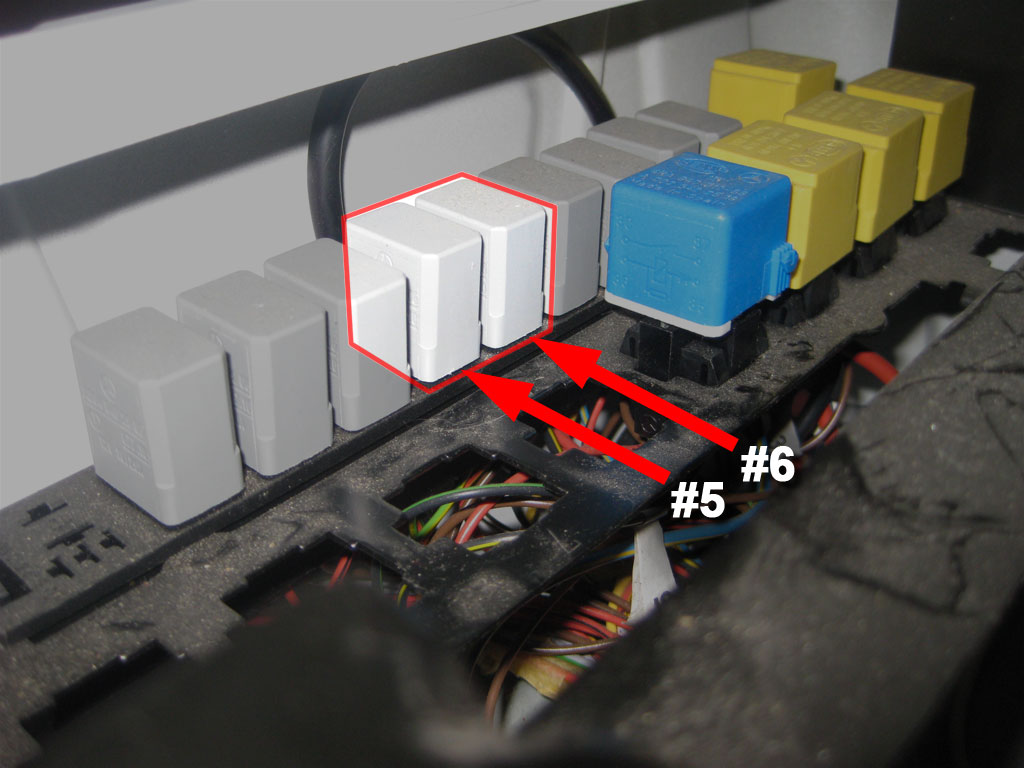 |
| The relay board in place, and location of the relays to remove |
With the board removed, you can see at the extreme front of the underseat area two rows of relays. The relays in which we're interested are the fourth and fifth from the left in the photo above (the driver's door is to camera left). These are plugged into sockets molded into a long black plastic box - we'll call that the "relay board." You can just see to the left of the left-most grey relay an empty relay socket - five holes in the black plastic. This bears a label embossed in the plastic which reads "#1." The two relays which you'll be removing are labeled "#5" and "#6," but the label is embossed into the socket surface under the relay, and is NOT visible until the relay is removed.
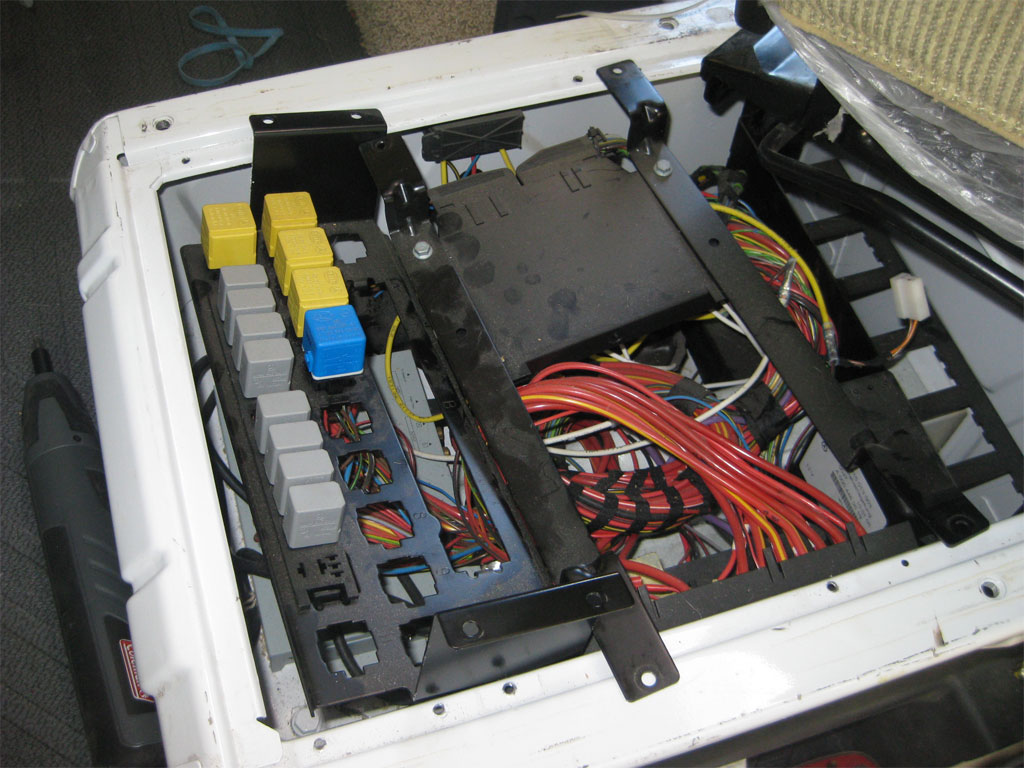 |
| Both suspended rails unfastened and shifted rearward to allow access to #5 and #6 grey relays |
The relays are mounted in very cramped quarters and require somewhat high effort to unplug. You may find that you can get enough grip with your fingers on what little of the relay bodies you can reach. After some frustrating attempts at this, I decided against prying or grasping with a tool, and decided to unmount the entire rail holding the relay board, so it could be shifted a few inches rearward to gain access to the relays. This also requires removing another electronic assembly just aft of the relay board. These two assemblies are suspended across the top of the now-exposed under-seat box, and held in place by a total of six T-25 Torx screws. Once the Torx screws are out, gently move both rail assemblies rearward a few inches, being careful not to unnecessarily move the many wires connected beneath.
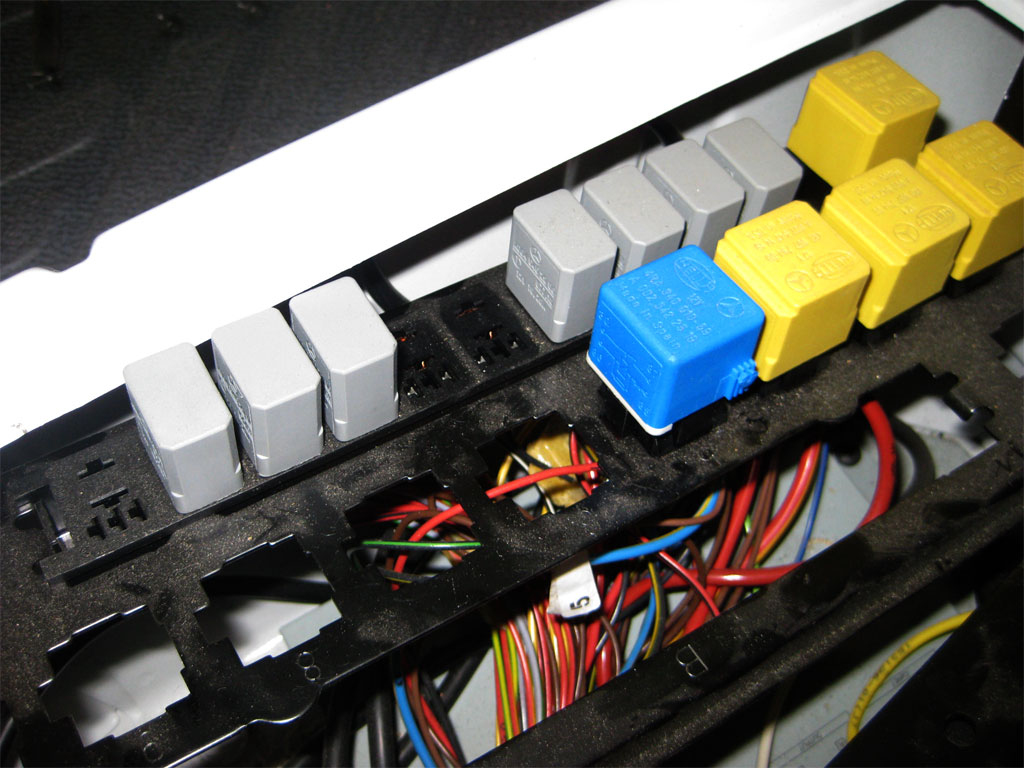 |
| Here, the #5 and #6 relays have been removed |
Once the relay board is moved rearward a bit, you can more easily remove the two relays. Grasp firmly and pull them straight up and out of the socket board. Again, there are NO locking mechanisms retaining the relays - only a tight friction fit on the electrical connectors. It may be helpful to gently wiggle the relay while pulling to free them from their sockets if necessary, but avoid aggressive rocking that might fatigue and damage metal or plastic parts. Again, be gentle with manipulating the bundle of wires beneath the relay board. After the relays are out, confirm that the now-empty sockets beneath them are labeled "#5" and "#6."
Return the relay board and the center electrical assembly to their original positions and re-install the six Torx screws.
At this point, you should test your work before replacing the seat assembly. Reconnect the chassis battery. Using the wireless remote key fob, try locking and unlocking the doors while observing the front, side and rear running lights on both sides. If memory serves, the #6 relay controlled the driver-side (vehicle left) lamps, and the #5 the passenger side. Be sure to visually check both sides. If one side or the other still flashes, you have removed the wrong relay(s).
If the test is successful, you can:
After removing the relays, I tested the systems I thought might be affected by the change: hazard lights, turn signals, brake lights, headlights, etc. I found nothing that appears affected, but it's certainly possible that I missed something. Again, if you find something, please let me know:
![]()
